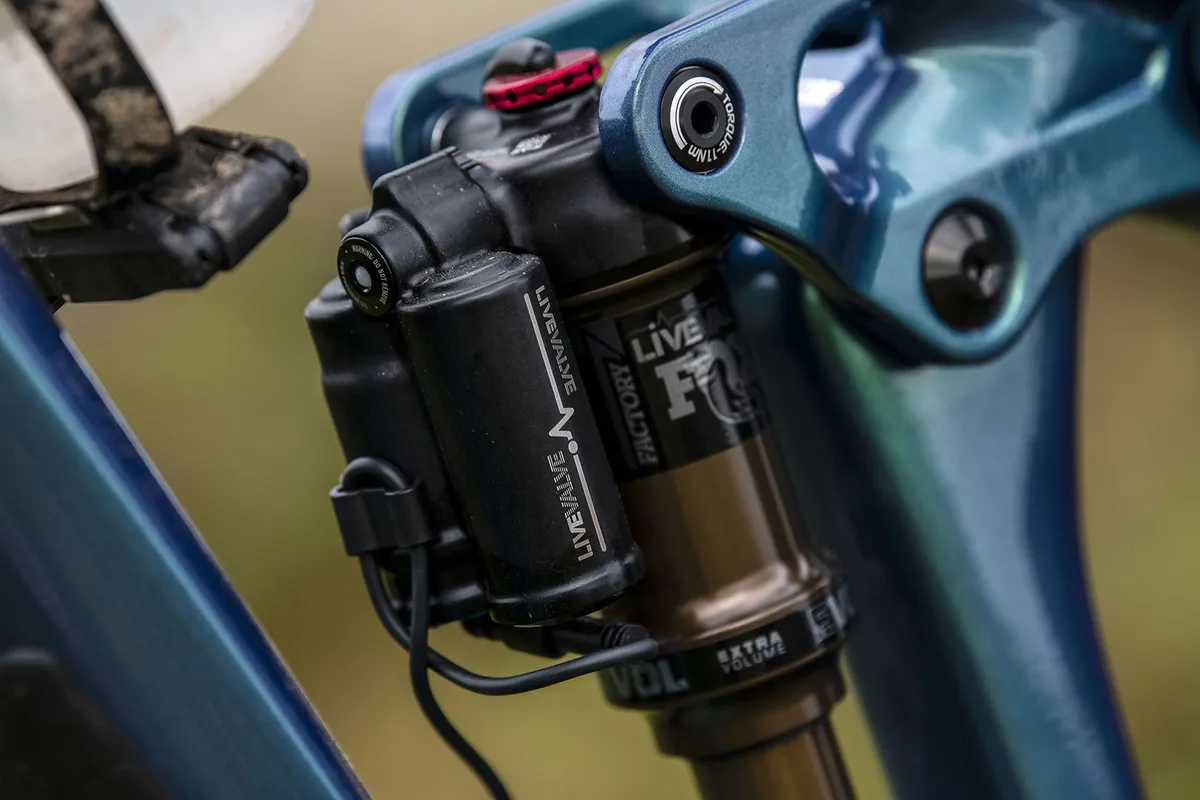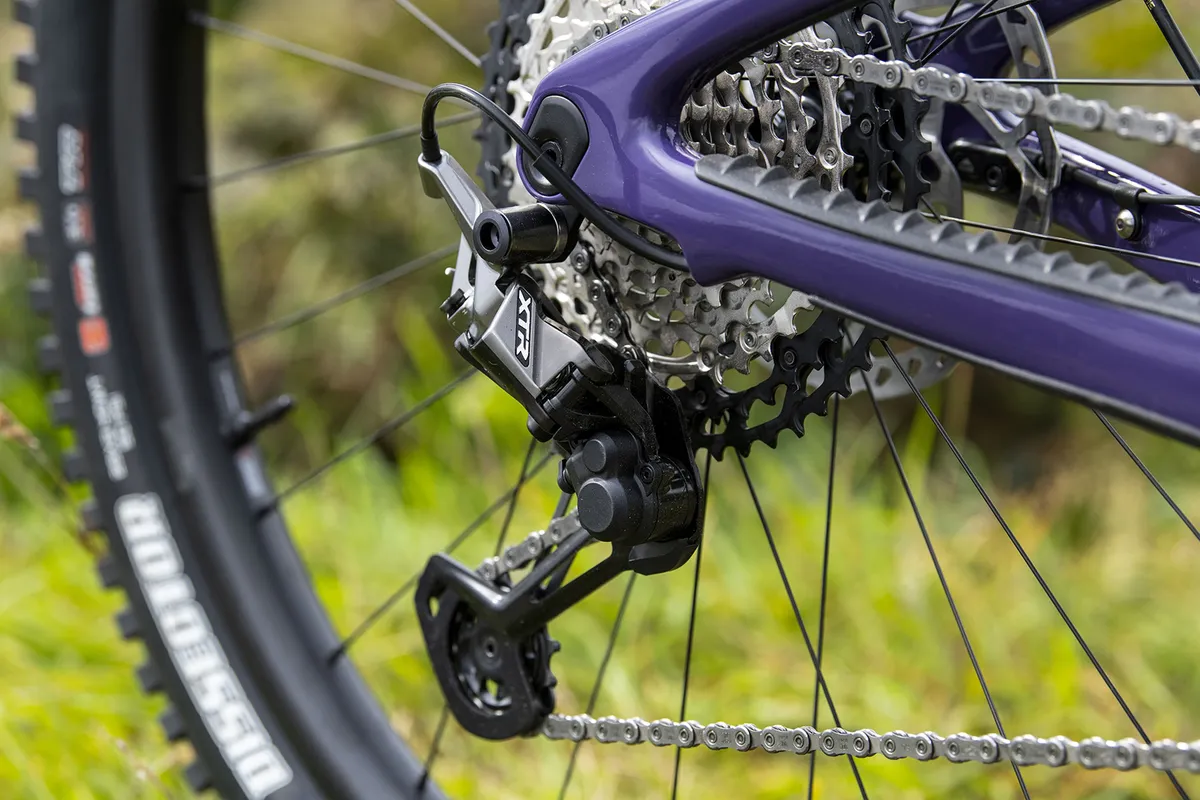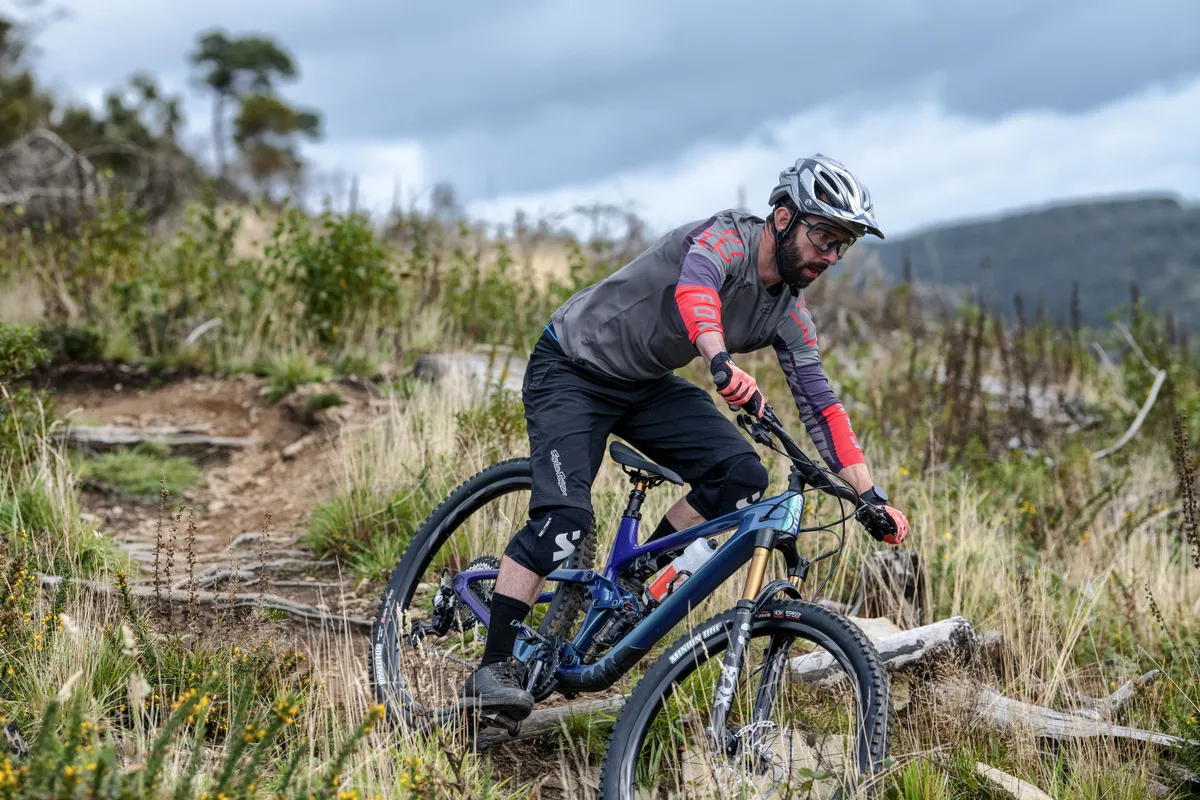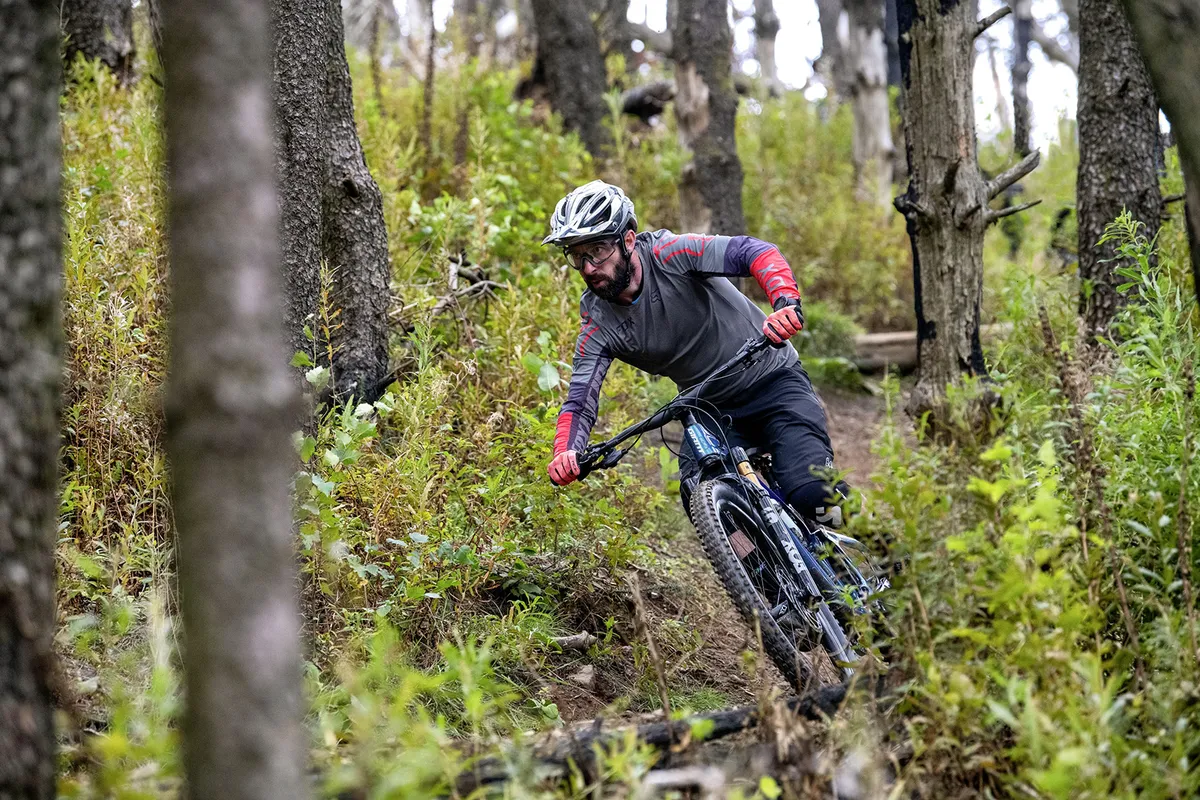Giant first released the Trance to the general public back in 2005. It was one of the first crop of bikes to use its new (at the time) twin-link Maestro Suspension system and offered just 100mm of travel.
- Giant adds all new carbon Trance X Advanced Pro 29 to 2021 line up
- The 2020 Giant Reign rolls on 29er wheels and is rowdier than ever
- The Giant Trance X 29 is a trail bike with enduro ambitions
Over the years, the Trance has progressively changed to keep up with the sport, but its intentions remain the same. This is a pure trail bike designed to be just as good at climbing as it is descending, plus everything in between.
Five things you need to know about Giant's new Trance X Advanced Pro 29 0
- It's got built-in Fox Live Valve integration with five user-selectable modes that electronically control the bike's suspension
- The frame, including two pivot links, are made from carbon fibre
- It has two user-adjustable geometry settings
- Progressive geometry makes it at home on a host of different trails
- Impressive spec adds to the refinement of the whole package
But where does this new Trance X Advanced Pro 29 come in? According to Giant, there was a gap between the standard 115mm travel Trance 29 and its full-on enduro race machine, the Reign, which has 146mm of rear wheel bounce.
The new Trance X 29 range effectively plugs that gap and caters for trail riders that are keen on pushing themselves and their bikes that bit harder.
Giant Trance X Advanced Pro 29 0 frame and suspension details
This all-new full carbon frame sports 135mm of travel that's delivered using the brand's twin-link Maestro suspension system.
And we say full carbon because Giant hasn’t scrimped on using the material – along with carbon front and rear triangles, both linkages are carbon too.

Giant claims the 135mm of rear wheel travel has been carefully tuned to balance traction and support with just enough ramp up at the end of the stroke to avoid any harsh bottom out when you do get close to pushing the o-ring towards the end of the shock shaft.
Overall progression is 15.8 per cent in the low setting and 15.9 per cent in the high setting and Giant claims the leverage ratio curves in both settings run parallel with one another, meaning you shouldn't feel anything odd or quirky in one setting over the other.
Fox Live Valve integration
However, the big news on the Trance X Advanced Pro 29 0 is the use of Fox’s Live Valve system.
Thanks to a series of accelerometers – one on the fork, one in the control unit which sits on the underside of the top tube and one by the rear axle – and a pitch sensor, the suspension can essentially do the thinking for you, firming both the fork's and shock's dampers when you’re hammering the pedals, or opening up and smoothing the bumps out as soon as it senses a disturbance in the trail by closing or opening electronically controlled valves.

The valves stay open for a set amount of time before they close automatically, unless another bump is detected, at which point the impact timer starts over again.
There are five Live Valve modes. The impact timer leaves the valves open for longest amount of time in the first setting and the shortest in the fifth setting, and each mode also boasts a different compression sensitivity to bump impacts.
In the simplest terms, the higher the setting, the more force is required to open the valves in the fork or shock.
Giant says that using Live Valve was by no means a way to mask the suspension performance of the Trance X Advanced Pro 29 0. It’s more that the product team felt by using it, it could create the ultimate trail bike that instantly reacts to the terrain and selects the most appropriate setting without the rider needing to worry.

Since Live Valve launched Fox has said it will work with brands on tuning settings so that brands can spec it on their bikes, and Giant was quick to take it up on the offer.
While the first few Live Valve settings worked well enough for what Giant was after, it did decrease the impact timer and sensitivity in the fourth and fifth settings to create a bike that, in its words: “felt more like a pure-bred cross-country machine”.
To better deal with all the associated cabling that comes with Live Valve, Giant has added internal sleeving to help manage things and reduce noise.
In a bid to improve durability and help to avoid costly maintenance bills racking up too quickly, the new Trance X Advanced Pro 29 features double-sealed pivot bearings throughout to help increase maintenance intervals.
Built-in frame protection
Keeping this sophisticated carbon frame protected and quiet are integrated rubber protectors.
There’s a heavily textured chainstay protector, which Giant says is made from softer and thicker rubber than used on other bikes to help quieten unwanted chainslap.

Giant has also used the same durometer rubber to create the down tube protector that hugs the under-belly of the bike tightly.
Clear 3M protector tape that sits on the upper third of the down tube helps prevent tailgate damage to the underside of the bike, should you regularly stow your bike in the back of a pickup truck.
Not everyone will be too pleased about the use of a press-fit bottom bracket, though.
Giant Trance X Advanced Pro 29 0 geometry

The big news is that the Trance X range is the first to feature a high and low setting since Giant began using the Maestro suspension system.
Thanks to an ovalised chip that sits in the upper rocker link (the seatstay/rocker link pivot to be precise) you can quickly and easily alter the bike's dimensions and feel with just a 5mm Allen key.
Switching from the high to low setting sees a massive 10mm drop in bottom bracket height – taking the drop from 30mm to 40mm – while the head angle slackens from 66.2 to 65.5 degrees.
The seat angle is really steep at 77.9 degrees and only reduces by 0.7 degrees (to 77.2 degrees) in the low setting, which remains really steep compared to many of this bike's counterparts and should help to create a really efficient climbing position on the bike.
The effective chainstay length grows from 435mm in the high setting to a marginally more stable 438mm in the low.
- Seat tube length: 430mm
- Seat angle: 77.2–77.9 degrees
- Head angle: 65.5–66.2 degrees
- Top tube (effective): 595–597mm (medium)
- Reach: 456–464mm
- Chainstay: 435–438mm
- Wheelbase: 1,203–1,205mm
- Standover: 729–737mm
- Stack: 615–621mm
- Head tube length: 1,00mm
- Sizes (*tested): S, M*, L, XL
Reach numbers are pretty progressive and not too far off Giant’s enduro machine, the Reign. In fact, if you compare both bikes in medium, the Trance X Advanced Pro 29 0 is actually 1mm longer with a generous reach of 456mm (in the low setting).
At 430mm the seat tube on the medium is decently short and comfortably accommodates the 150mm drop post. Giant has ensured there’s enough room for longer droppers by shifting the seat tube pivot position slightly ahead of the seat tube to gain valuable space – just as it did on the Reign 29 not so long ago.
Giant Trance X Advanced Pro 29 0 specifications

The real focal point is Fox’s Live Valve suspension system which, in this case, is controlling a Fox 36 Factory fork complete with FIT4 damper and a DPX2 Factory shock.
Shimano takes care of the drivetrain but while most of the transmission is from its 12-speed XT range, Giant has added an XTR rear derailleur.
All Trance X Advanced Pro 29 bikes use four-piston brakes and in this case, they’re Shimano XT numbers which, thankfully, don’t seem to be suffering from a wandering bite point.

Giant has included an MRP chain guide, complete with bash guard to better protect the chainring and keep the chain firmly in place. It’s certainly a nod to just how aggressively Giant expects this new bike to be ridden.
There’s no shortage of carbon kit, too. Giant’s new Contact SLR bar is 800mm wide with a 20mm rise. This new version sports a more aggressive 7- rather than 9-degree back sweep.
Giant also supplies the stem and its new Romero SL saddle along with carbon TRX-1 wheels. These feature rims with a 30mm internal width and are wrapped in Maxxis rubber.
At the front there’s the formidable Minion DHF, while at the rear there’s the relatively new Dissector. Both tyres use the EXO casing and 3C MaxxTerra rubber compound, and they’re set up tubeless from the get-go.
Giant Trance X Advanced Pro 29 0 ride impressions

Ride time aboard the Trance X Advanced Pro 29 0 has been quite limited because I’ve not had it long, but my handful of rides have given me a good idea about how it’ll behave on the trail.
After hitting some of the finest winch up, plummet down trails in South Wales, I’ve also had a couple of big outings where I’ve ridden everything from flat, technical singletrack with punchy root-riddled climbs, to higher-speed downhill runs with jumps and heavy compressions.
Giant Trance X Advanced Pro 29 0 climbing performance
Giant touts the Trance X Advanced Pro 29 0 as suited to 50 per cent climbing and 50 per cent descending. And on the trail, so far at least, it certainly doesn’t disappoint.
There are a number of factors as to why things feel so capable and easy-going uphill.
That steep seat angle (even in the low position) perches your hips nicely over the bottom bracket, which helps to keep things feeling not just comfortable but efficient too.
This is magnified by the Live Valve system, which reacts almost instantaneously as the pitch of the trail increases, firming up the suspension and preventing it from sinking too deep into the travel. This, in turn, ensures your efficient position on the bike is maintained.

Then there’s the 13.54kg weight. Don’t get me wrong, this is by no means a featherweight cross-country machine, but it’s far from a heavyweight either.
Add in the stiffness through the frame when you really start winding the power on and it soon becomes clear just how eager this thing is to accelerate when you want it to.
On faster climbs, the Dissector rear tyre seems to roll well enough and should the ground loosen up it’ll do a decent job of generating enough traction to keep you moving forward.
While the seated position isn’t the most stretched out, it’s comfortable and I never felt cramped or awkward on any of the climbs I attempted. Even in tight, loose, uphill switchbacks I felt confident placing my wheels exactly where I wanted them to be and never struggled with the front wheel lifting as I shifted position slightly to manoeuvre my way around corners.
I generally left the Live Valve in the most open, active setting, but when I did experiment with the firmer settings, it was impressive just how different the bike felt.
While it could still open up and absorb larger, step-like impacts on the trail, it felt noticeably firmer and even more efficient, which was a real plus on smooth uphill drags where keeping energy usage to a minimum was a priority.
Giant Trance X Advanced Pro 29 0 descending performance

On mellower technical trails, despite concerns that the Live Valve system wouldn’t react fast enough, I soon found myself forgetting it was working away in the background and just got on with the riding.
Turn it off and it’s almost instantly obvious just how big an impact it has on the suspension. Its functionality is impressive but I still feel the overall packaging could be a little more refined.
That’s because one of the first things I noticed when tackling rougher descents was quite a bit of cable rattle, mainly from the cable junction that sits close to the fork sensor, positioned behind the fork arch.
While it wasn’t exactly off-putting, I’m a big fan of silent bikes and would rather not have to try and silence that rattle myself, especially considering just how expensive this bike is.
Reducing rattle is possible though, and I’ll endeavour to tidy the additional cabling myself to see if it cures the problem. Obviously this is a minor problem, but hard to ignore on such an expensive bike.
Cable rattle aside, the ride on descents is really impressive. I instantly felt comfortable on the Trance X Advanced Pro 29 0.
Giant seems to do a good job of creating bikes that feel well-balanced from the get-go and this is no different. Pushing it into the turns, I felt like my weight was evenly distributed between the wheels and I managed to get up to speed and feel confident almost immediately.
On rougher trails, the back-end of the bike feels impressively active and offers good levels of comfort, feeling smoother than the Reign at times.
I was impressed by how much cornering traction I could generate when I needed to, thanks in part to how well it tracked the contours of the terrain.
There’s a decent amount of support on smoother trails thanks to the Live Valve tweaking settings to suit. This was a real plus on high-speed jump lines with incredibly smooth transitions and some smaller pumpable bumps – the bike felt like it offered plenty of support to push against.

The Fox 36 uses the FIT4 damper which is decently supportive, but doesn’t feel as comfortable or as refined as its GRIP2 counterpart when the hits come thick and fast. I found running it a touch softer than a GRIP2 fork helped to gain more in terms of comfort, but at the cost of support.
When it comes to the high and low geometry settings, thanks to the difference between the two you really can feel a difference on the trail.

While I love a low bottom bracket, at 335mm in the low setting I did occasionally catch my pedals on rocks or roots when riding some chunky, root-riddled pedally sections or on awkward steppy climbs. Switching into the high position lifts the bottom bracket enough to seemingly avoid this in most instances.
It does however remove some of that cornering confidence that a low bottom bracket gives. But, as it’s quick and easy enough to change between high and low settings with a multi-tool on the trail, it’s not a massive issue and it’s nice to know you can quickly adapt the bike’s characteristics to suit whatever trail you might be riding that day.
In terms of the spec, it’s all generally positive so far. I’m a big fan of how sharp and powerful the XT brakes feel and, thankfully, the set I have here don’t have a wandering bite point.
I’m also a big of the Maxxis tyre combo, especially in the dry and loose conditions I’ve been testing this bike in. They feel dependable and consistent, with a very predictable feel through the turns.
Giant’s new Romero saddle is really comfy on long climbs too, and I got on well with the Contact SLR carbon bar and stem.
Giant Trance X Advanced Pro 29 0 early verdict

The new Trance X Advanced Pro 29 0 is a brilliantly fun trail bike that offers great geometry with some useful adjustments, especially if you like to mix up the types of trails you ride.
Fox’s Live Valve system works well and makes this an exceptionally efficient bike by tweaking your fork and shock on the fly leaving you to simply keep on pedalling.
Yes, it does add an additional layer of complexity, a battery and some wires, but so far it’s been working extremely effectively. I need to silence that irritating cable rattle, though.
I’d also be intrigued to ride a similarly specced Trance X Advanced Pro 29 minus the Live Valve system (ideally with a fork and shock that feature external compression adjustment) just to see how it truly compares on the trail.
Tune in for the full review soon.
Product
| Brand | Giant |
| Price | A$11499.00, £7999.00, $8500.00 |
| br_whatWeTested | Giant Trance X Advanced Pro 29 0 |
| Weight | 13.54kg |
Features
| Fork | Fox 36 Float Factory Live Valve FIT4 |
| Stem | Giant Contact SL 35 |
| Chain | Shimano XT |
| Frame | Carbon |
| Tyres | Maxxis Minion DHF 2.5in 3C MaxxTerra EXO (front), Maxxis Dissector 2.4in 3C MaxxTerra EXO (rear) |
| Brakes | Shimano XT |
| Cranks | Shimano XT |
| Saddle | Giant Romero SL |
| Wheels | Giant TRX-1 Carbon |
| Shifter | Shimano XT |
| Cassette | Shimano XT 10-51t |
| Seatpost | Fox Transfer Factory |
| Grips/tape | Giant |
| Handlebar | Giant Contact SLR Carbon |
| Rear shock | Fox Float DPX2 Factory Live Valve |
| Bottom bracket | PF92 |
| Available sizes | Small, medium, large, extra-large |
| Rear derailleur | Shimano XTR |
| Features | Fox Live Valve |


